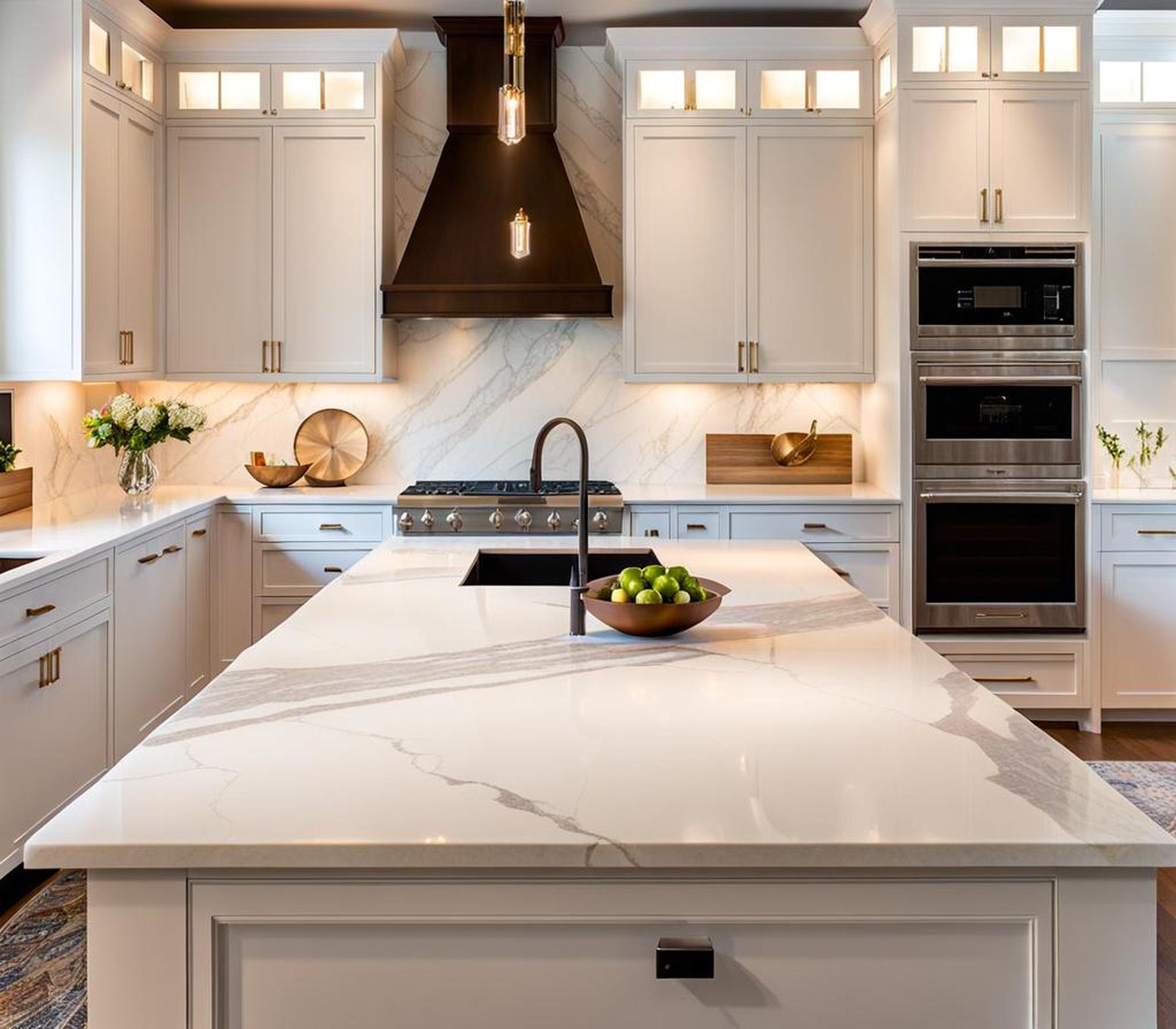Many people have fallen in love with the look of high-end kitchens because of the popularity of home improvement shows. One of the most coveted materials is marble, with its elegant white background and gorgeous gray veining. However, natural marble requires careful maintenance and can be prone to etching and stains. This is where engineered quartz enters the picture, offering the beauty of marble without as much upkeep. One of the most on-trend quartz options today is Calacatta Valentin.
Calacatta Valentin quartz mimics luxurious Calacatta marble with its warm white background, subtle gray veining, and touches of gold. This engineered stone combines the best aspects of natural stone and man-made materials. While the aesthetic appeal of Calacatta Valentin can make it highly desirable for kitchen countertops, it’s important to weigh all the pros and cons before deciding it’s the right choice.
Pros of Calacatta Valentin Quartz Countertops
There are several compelling reasons Calacatta Valentin has become a sought-after quartz choice for today’s kitchens:
Unmatched Beauty
The distinctive look of Calacatta Valentin quartz sets it apart. The white and gray tones create an elegant, high-end appearance, while the touches of gold veining add just a subtle hint of glamour. This unique style works beautifully in contemporary, modern, transitional, and traditional kitchen settings.
Calacatta Valentin is a versatile neutral that allows other elements like cabinetry, tile, and decor to pop. It feels clean and bright. The melding of gray and white is soft yet dramatic. Bottom line – this quartz looks far more expensive and luxurious than many other options.

Superior Durability
Quartz is one of the toughest countertop materials available today. It’s even stronger than granite. Calacatta Valentin quartz is practically indestructible under normal kitchen use. It resists scratches, chips, cracks, and heat. You don’t have to fret over red wine stains or tomato sauce spills. It’s non-porous so it won’t absorb liquids. You can prep food directly on it without worry.
In high traffic areas like kitchens that see heavy daily use, Calacatta Valentin quartz simply outperforms more delicate natural stone. There is no sealant required either. This hardwearing material can stand up to kids, pets, and busy cooks.
Low Maintenance Needs
One of the biggest perks of quartz is that it’s easy to keep looking pristine. Just use a mild soap and water to wipe the countertop clean. No special stone cleaners or polish required. You’ll never have to re-seal it either.
Beyond routine cleaning, Calacatta Valentin needs virtually no maintenance even after years of use. It will not harbor bacteria growth. You can enjoy peace of mind knowing your counters are hygienic as well as beautiful.
Customization Options
Calacatta Valentin is just one standout choice from the Caesarstone brand’s wide range of quartz patterns and colors. This diversity allows consumers to find the perfect look for their unique kitchen design vision.
With quartz you aren’t as limited in edging and cutout options compared to natural stone. Curved edges, cooktop cutouts, integrated sinks, and built-in drainboards can be accommodated.
Thicker slab options like 3 cm provide flexibility for different applications. Quartz makes an ideal backsplash material that seamlessly matches the countertops.
Potential Downsides of Calacatta Valentin Quartz
For all its advantages, Calacatta Valentin quartz also comes with a few cons to factor in:
Appearance Limitations
The pattern repetition that occurs with engineered quartz may be noticeable upon very close inspection, unlike natural stone with more variation. Seams can also be slightly more apparent with quartz.
While magnificent, Calacatta Valentin won’t offer quite the same depth, movement, and one-of-a-kind finesse as real exotic marble. The look emulates natural stone but doesn’t fully duplicate it.
Higher Price Point
Calacatta Valentin quartz sits at the higher end of the price range for engineered stone countertops. The unique aesthetics and brand reputation bring a premium cost. While durable, it is more expensive than basic quartz.
Some marble and granite options can be comparable or less costly. But the installation and maintenance fees over time may elevate the overall investment for natural stone.
Limitations on Repairs
No material is impervious to damage. A benefit of natural stone is being able to sand and polish localized damaged areas. But with quartz, scratches or chips will likely mean replacing the entire affected slab or section.
Supply Chain Challenges
The booming popularity of quartz has led to supply chain constraints. Currently, lead times can stretch 6 months or longer. Stock limitations and market volatility are things to keep in mind.
Calacatta Valentin quartz offers district high-end aesthetics and durability that make it a coveted choice for kitchen countertops. The white and gray marble-look background coupled with subtle gold veining creates a statement. Yet there are potential drawbacks to weigh against the benefits, from the higher cost to appearance limitations.
Ultimately, the pros and cons will come down to individual priorities. For those seeking a low-maintenance material with luxury visuals, Calacatta Valentin is hard to beat. But natural stone may better suit some homeowners’ needs and preferences. Understanding the trade-offs allows for an informed decision when selecting the ideal countertop.
